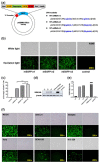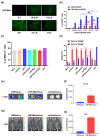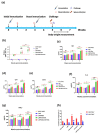mRNA Vaccines Encoding the HA Protein of Influenza A H1N1 Virus Delivered by Cationic Lipid Nanoparticles Induce Protective Immune Responses in Mice
- PMID: 32164372
- PMCID: PMC7157730
- DOI: 10.3390/vaccines8010123
mRNA Vaccines Encoding the HA Protein of Influenza A H1N1 Virus Delivered by Cationic Lipid Nanoparticles Induce Protective Immune Responses in Mice
Abstract
The design of the mRNA vaccine involves the selection of in vitro transcription (IVT) systems and nonviral delivery vectors. This study aimed to verify the effect of 5' and 3' untranslated region (UTR) sequences on the translation efficiency of mRNA. Three modes of IVT-mRNA systems (IVT-mRNA-n1/n2/n3) with diverse UTRs were constructed, and EGFP (enhanced green fluorescent protein) and HA (hemagglutinin) gene of H3N2 influenza virus were introduced into each of them. The results showed that the mode of 5' and 3' UTRs originating from human β-globulin was better than the mode of UTRs from human α-globulin, and the n3 mode was the best. mEGFP-n3, mH3HA-n3, and mLuciferease-n3 were prepared to compare the effect of cationic lipid nanoparticle (LNP) with that of mannose-conjugated LNP (LNP-Man) on the efficiency of gene delivery. The results showed that the effect of LNP-Man was better than that of LNP both in vitro and in vivo. Choosing appropriate ligands might help in vaccine design. After selecting the IVT-mRNA-n3 system and delivery vectors, mRNA vaccines were constructed against the H1N1 influenza virus, and C57BL/6 mice were immunized through intranasal administration. The results showed that mRNA vaccines could elicit both humoral and cellular immune responses and completely protect mice from the tenfold LD50 H1N1 influenza virus challenge.
Keywords: cationic lipid nanoparticles; influenza A H1N1 virus; intranasal administration; mRNA vaccine; mannose.
Conflict of interest statement
The authors declare no conflicts of interest. The sponsors had no role in the design, execution, interpretation, or writing of the study.
Figures






Similar articles
-
Self-Amplifying mRNA Vaccines Expressing Multiple Conserved Influenza Antigens Confer Protection against Homologous and Heterosubtypic Viral Challenge.PLoS One. 2016 Aug 15;11(8):e0161193. doi: 10.1371/journal.pone.0161193. eCollection 2016. PLoS One. 2016. PMID: 27525409 Free PMC article.
-
[Immune protective effectiveness of seasonal influenza spilt vaccine against homologous and heterogonous subtypes of influenza virus in mice].Bing Du Xue Bao. 2011 May;27(3):265-73. Bing Du Xue Bao. 2011. PMID: 21774253 Chinese.
-
Development of a Pan-H1 Influenza Vaccine.J Virol. 2018 Oct 29;92(22):e01349-18. doi: 10.1128/JVI.01349-18. Print 2018 Nov 15. J Virol. 2018. PMID: 30185594 Free PMC article.
-
Non-Immunotherapy Application of LNP-mRNA: Maximizing Efficacy and Safety.Biomedicines. 2021 May 10;9(5):530. doi: 10.3390/biomedicines9050530. Biomedicines. 2021. PMID: 34068715 Free PMC article. Review.
-
mRNA vaccine delivery using lipid nanoparticles.Ther Deliv. 2016;7(5):319-34. doi: 10.4155/tde-2016-0006. Ther Deliv. 2016. PMID: 27075952 Free PMC article. Review.
Cited by
-
mRNA Vaccine Mitigates SARS-CoV-2 Infections and COVID-19.Microbiol Spectr. 2023 Feb 14;11(1):e0424022. doi: 10.1128/spectrum.04240-22. Epub 2023 Jan 25. Microbiol Spectr. 2023. PMID: 36695597 Free PMC article.
-
Recent Advances in Messenger Ribonucleic Acid (mRNA) Vaccines and Their Delivery Systems: A Review.Clin Pharmacol. 2023 Aug 3;15:77-98. doi: 10.2147/CPAA.S418314. eCollection 2023. Clin Pharmacol. 2023. PMID: 37554660 Free PMC article. Review.
-
Unlocking the Therapeutic Applicability of LNP-mRNA: Chemistry, Formulation, and Clinical Strategies.Research (Wash D C). 2024 Jun 18;7:0370. doi: 10.34133/research.0370. eCollection 2024. Research (Wash D C). 2024. PMID: 38894715 Free PMC article. Review.
-
Respiratory delivered vaccines: Current status and perspectives in rational formulation design.Acta Pharm Sin B. 2024 Dec;14(12):5132-5160. doi: 10.1016/j.apsb.2024.08.026. Epub 2024 Nov 4. Acta Pharm Sin B. 2024. PMID: 39807330 Free PMC article. Review.
-
Polymeric cGAMP microparticles affect the immunogenicity of a broadly active influenza mRNA lipid nanoparticle vaccine.J Control Release. 2024 Aug;372:168-175. doi: 10.1016/j.jconrel.2024.06.007. Epub 2024 Jun 19. J Control Release. 2024. PMID: 38844178 Free PMC article.
References
-
- Brazzoli M., Magini D., Bonci A., Buccato S., Giovani C., Kratzer R., Zurli V., Mangiavacchi S., Casini D., Brito L.M., et al. Induction of Broad-Based Immunity and Protective Efficacy by Self-amplifying mRNA Vaccines Encoding Influenza Virus Hemagglutinin. J. Virol. 2016;90:332–344. doi: 10.1128/JVI.01786-15. - DOI - PMC - PubMed
Grants and funding
LinkOut - more resources
Full Text Sources
Other Literature Sources
Research Materials

